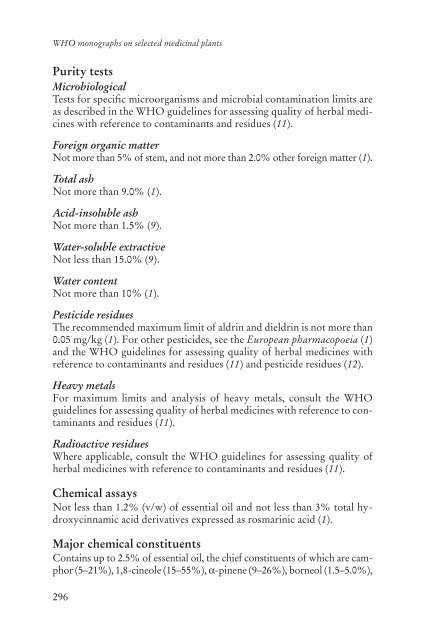WHO monographs on selected medicinal plants - travolekar.ru
WHO monographs on selected medicinal plants - travolekar.ru
WHO monographs on selected medicinal plants - travolekar.ru
Create successful ePaper yourself
Turn your PDF publications into a flip-book with our unique Google optimized e-Paper software.
<str<strong>on</strong>g>WHO</str<strong>on</strong>g> <str<strong>on</strong>g>m<strong>on</strong>ographs</str<strong>on</strong>g> <strong>on</strong> <strong>selected</strong> <strong>medicinal</strong> <strong>plants</strong><br />
Purity tests<br />
Microbiological<br />
Tests for specific microorganisms and microbial c<strong>on</strong>taminati<strong>on</strong> limits are<br />
as described in the <str<strong>on</strong>g>WHO</str<strong>on</strong>g> guidelines for assessing quality of herbal medicines<br />
with reference to c<strong>on</strong>taminants and residues (11).<br />
Foreign organic matter<br />
Not more than 5% of stem, and not more than 2.0% other foreign matter (1).<br />
Total ash<br />
Not more than 9.0% (1).<br />
Acid-insoluble ash<br />
Not more than 1.5% (9).<br />
Water-soluble extractive<br />
Not less than 15.0% (9).<br />
Water c<strong>on</strong>tent<br />
Not more than 10% (1).<br />
Pesticide residues<br />
The recommended maximum limit of aldrin and dieldrin is not more than<br />
0.05 mg/kg (1). For other pesticides, see the European pharmacopoeia (1)<br />
and the <str<strong>on</strong>g>WHO</str<strong>on</strong>g> guidelines for assessing quality of herbal medicines with<br />
reference to c<strong>on</strong>taminants and residues (11) and pesticide residues (12).<br />
Heavy metals<br />
For maximum limits and analysis of heavy metals, c<strong>on</strong>sult the <str<strong>on</strong>g>WHO</str<strong>on</strong>g><br />
guidelines for assessing quality of herbal medicines with reference to c<strong>on</strong>taminants<br />
and residues (11).<br />
Radioactive residues<br />
Where applicable, c<strong>on</strong>sult the <str<strong>on</strong>g>WHO</str<strong>on</strong>g> guidelines for assessing quality of<br />
herbal medicines with reference to c<strong>on</strong>taminants and residues (11).<br />
Chemical assays<br />
Not less than 1.2% (v/w) of essential oil and not less than 3% total hydroxycinnamic<br />
acid derivatives expressed as rosmarinic acid (1).<br />
Major chemical c<strong>on</strong>stituents<br />
C<strong>on</strong>tains up to 2.5% of essential oil, the chief c<strong>on</strong>stituents of which are camphor<br />
(5–21%), 1,8-cineole (15–55%), -pinene (9–26%), borneol (1.5–5.0%),<br />
296

















